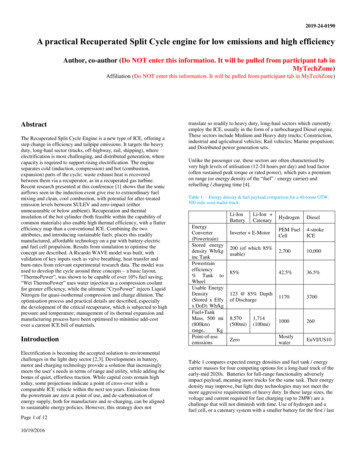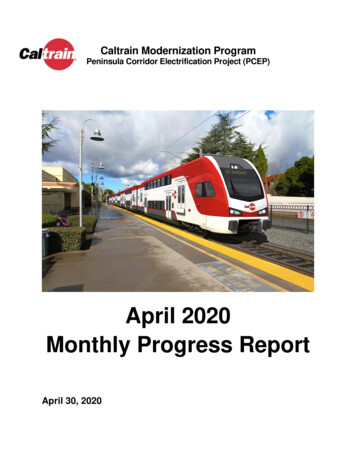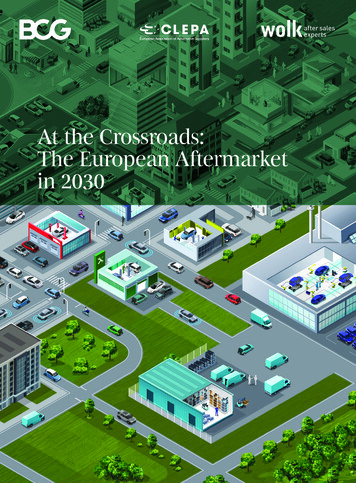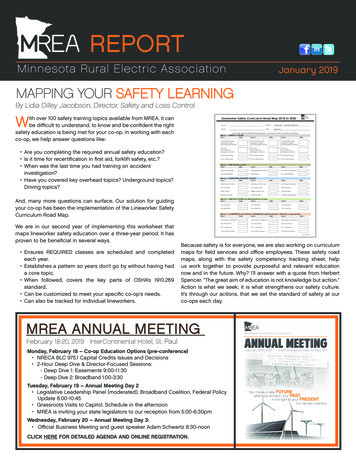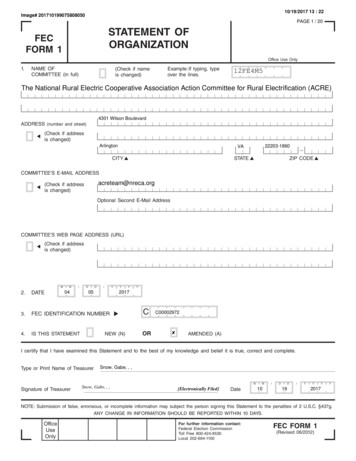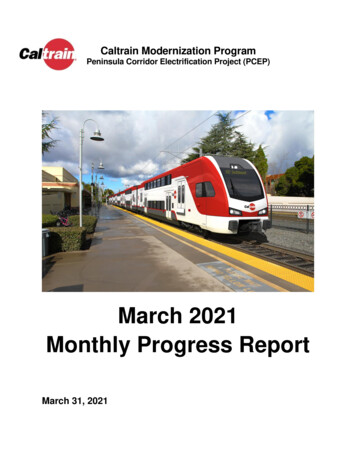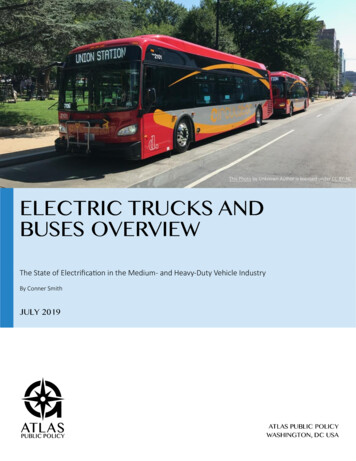
Transcription
This Photo by Unknown Author is licensed under CC BY-NCThe State of Electrification in the Medium- and Heavy-Duty Vehicle IndustryBy Conner Smith
590 million inpublic fundingfor electricbuses (43states) andtrucks (10states)Price Parity Estimates Electric TransitBuses: 1,650 Electric Trucks(all classes):300 Electric SchoolBuses: 150InvestmentDeploymentElectrification in the medium- and heavy-duty vehicle sector is increasing in the United States withCalifornia leading the way. Low commercialization for all vehicle categories other than transit busesand high upfront costs have limited deployment so far. Increasing investment in the sector from publicand private sources, however, is expected to generate growth and significantly increase the number ofelectric trucks and buses on the road in the near term. Upfront costs associated with electric trucksand buses are expected to decline significantly through 2030 as battery prices fall, making themcompetitive on a total cost of ownership (TCO) basis. Electric TransitBuses: 20192020 Electric SchoolBuses: 20252030 Electric Trucks:2025Electrification in the medium-and heavy-duty sector is on the rise in the United States. Globally themarket for electric trucks is expected to grow by 20 percent in 2019 [1]. Bloomberg estimates that 80percent of the global transit bus fleet will be electric by 2040 [2]. While transit buses are fully available atthe commercial level, electric shuttles, school buses, delivery trucks, refuse trucks, tractors, and drayagetrucks are in the early stages of commercialization. Electric freight trucks have not yet reached commercialavailability.The electric bus and truck industries continue to benefit from increased public funding through the VWSettlement and investment from leading manufacturers continues to expand deployment. California leadsthe nation in deployment of EVs and programs such as the Hybrid and Zero-Emission Truck and BusVoucher Incentive Project (HVIP), which have accelerated the deployment of zero emissions trucks andbuses. Through the program, 660 vouchers for as many ZEVs have been offered with concentrations in theBay Area and Los Angeles County [3]. New York offers a similar program through their Truck VoucherAcknowledgements: This report was supported by the Natural Resources Defense Council(NRDC). We thank in particular Simon Mui for their feedback and comments. The report’sfindings and conclusions are those of the authors and do not necessarily reflect the views ofNRDC.
Incentive Program and has set aside substantial VW funding for medium- and heavy-duty electrification[4]. In California, the HVIP program is supplemented by the California Low Carbon Fuel Standard (LCFS)Program and seeks a 20 percent reduction in the carbon intensity of the transport sector by 2030. Thiscredit market provides another resource for fleet owners to reduce the cost of electrification and wasvalued at 2 billion in 2018 [5].FIGURE 1: AVERAGE ANNUAL VEHICLE MILES TRAVELED OF MAJOR VEHICLE CATEGORIES IN 2018Class 8 Truck63,428Transit Bus34,012Refuse Truck25,000Paratransit Shuttle22,679Delivery Truck12,958School Bus12,000Light Truck/Van11,991Light-Duty 30,00040,00050,00060,00070,000This chart compares vehicle miles traveled by categories of medium- and heavy-duty vehicles with Class 8 faroutpacing other categories.Source: [6]The average annual vehicle miles travelled (VMT) by different categories of medium- and heavy-dutyvehicles varies significantly. Across all categories of medium- and heavy-duty vehicles, Class 8 trucks faroutpace other types of vehicles in terms of average vehicle miles travelled (VMT).Transit buses follow Class 8 trucks, with an average VMT more than three times higher than school busesand medium trucks. High VMT and emissions have helped to accelerate public pressure on transit buselectrification and that market has grown faster than other medium- and heavy-duty categories.Transit buses lead in terms of deployment, with 43 states investing in electric buses. By comparison, lessthan 10 states have invested public funds into medium- and heavy-duty ZEVs excluding buses [7].California is considering regulations that would require five percent of the state’s roughly 1.5 milliontrucks to be zero emission by 2030 [8]. At the end of 2018, the state passed regulations requiring that allnew transit buses purchased be zero emission by model year 2029 [9].
Bloomberg New Energy Finance estimates that there were 360 electric buses in the United States at theend of 2017 [2]. The market has been growing quickly, and CALSTART estimates that zero emission transitbuses will increase from one percent of the national fleet to 20 percent by 2030 [10]. Under the currentCalifornia grid mix, electric transit buses offer lifetime emissions reduction potential of up to 74 percent[11]. Their report from February 2019 estimates that there are 1,650 electric and fuel cell buses inoperation or on order across the country. Table 1 presents the estimates for the top states for zeroemission transit bus deployment from the CALSTART report, with California and Washington leading theway.TABLE 1: TOP STATES FOR ZERO EMISSION TRANSIT BUS DEPLOYMENT THROUGH AUGUST 2018StateNumber of llinois61Colorado44New York29Pennsylvania27Texas24South Carolina22Georgia21Kentucky21Total1,416This table highlights the top 10 states for zero emissions bus deployment according to CALSTART’s 2018 report.California is the national leader by a significant margin.Source: [10]The distribution of public funding for electric buses throughout the country generally supports thesedeployment estimates. Figure 2 shows that the states with the highest amount of public fundingallocated, marked with darker shades, are also included in CALSTART’s top 10 list.According to the EV Hub, 43 states have received public funding to purchase electric transit buses [12].Upfront costs of electric buses have come down from almost 1,200,000 in early commercializationperiods to roughly 750,000 today [11]. Despite progress, electric buses are still roughly twice asexpensive as diesel alternatives (see Table 2). Financing mechanisms like Proterra’s battery leasing
program, which allows customers to purchase the vehicle while leasing the battery from Proterra, couldmake electric buses even more accessible by lowering vehicle upfront costs [13]. Table 2 provides asummary of the price and technical differences between different transit bus models.Electric transit buses have achieved a lower total cost of ownership (TCO) than diesel and CNG-fueledbuses in some cases, although the likelihood of achieving savings remains uncertain. TCO is expected toimprove as upfront vehicle costs decline further. The 2018 ICF report, Medium- and Heavy-DutyElectrification in California, presents a range of lifetime cost calculations with lower TCO for electric busesin some cases and higher TCO in others. The report cites a study from the Los Angeles County MTA had alifetime cost of 4.27 per mile for electric buses compared to 4.18 per mile for CNG buses. The NationalRenewable Energy Laboratory (NREL) reports a higher levelized cost for electric buses of 4.43 per milecompared to 3.93 per mile for diesel buses [11].MillionsFIGURE 2: FUNDING AWARDS FOR ELECTRIC TRANSIT BUSES AS OF MAY 2019 200 150 100 50 0This chart shows the total amount of public funding for electric transit buses from 2011 through 2019 in the U.S.,demonstrating higher concentrations of buses in darker shades that generally support the CALSTART data.Source: [14]TABLE 2: TRANSIT BUS MODEL COMPARISONManufacturerModelFuel SourcePurchase CostRange (mi.)BYDK9SBattery Electric 770,000230GilligBRT ElectricBattery Electric 1,000,000200New FlyerXcelsior CHARGEBattery Electric 800,000230-260ProterraCatalyst E2Battery Electric 750,000169-276El DoradoAxessCNG 490,000NAGilligBRT CNGCNG 430,000NANew FlyerXcelsior CNGCNG 458,000NAEl DoradoArrivoDiesel 400,000NAGilligBRT DieselDiesel 380,000NA
ManufacturerModelFuel SourcePurchase CostRange (mi.)New FlyerXcelsior DieselDiesel 420,000NAEl DoradoAxess FCFuel Cell 1,200,000200-300New FlyerXcelsior CHARGE H2Fuel Cell 850,000260-300El DoradoAxess HybridHybrid Electric 630,000NAGilligBRT HybridHybrid Electric 635,000NANew FlyerXcelsior HybridHybrid Electric 650,000NAThis table provides estimates for the upfront costs of different transit bus models including several fuel types. Electricand fuel cell buses have a higher purchase price than other fuel types.Sources: Manufacturer websites are linked above in the table. Cost assumes 35 ft bus [15]Manufacturers such as Proterra self-report lifetime cost savings as high as 433,000 associated with theirtechnology [16]. These savings are slightly higher than estimates made by the California Air ResourcesBoard, calculating that electric transit buses could generate lifetime savings of up to 400,000 comparedto diesel buses and 200,000 compared to CNG buses by 2020 [11]. Public programs such as the FederalLow-No Emissions program can bring the upfront costs of electric transit buses down, improving thebusiness case. The Low-No program has already allocated more than 230 million to electric transit busessince 2015.Grant programs make a significant difference according to forthcoming report by ICF. This analysisincluded grants from HVIP, LCFS, and electric utility programs. Current California transit buses with publicsubsidies of approximately 250,000 per vehicle are estimated to have an average TCO roughly 140,000lower than diesel alternatives. This will improve over time, where electric transit bus TCO is expected tobe 240,000 lower than diesel alternatives by 2030 without public subsidies but with the LCFS remainingin place [17].According to the Vermont Energy investment Corporation (VEIC), less than 50 school buses out of morethan 400,000 nationwide were electric as of May 2018 [18]. School buses outnumber transit busesroughly five to one [11]. Throughout 2018, school districts across California took the lead and deployed150 buses with support from public agencies [19]. Electric utilities are emerging as a key partner forelectric school bus adoption and several pilot projects are operating throughout the county. Several statesincluding Vermont, New York, Illinois, Minnesota, and Massachusetts are developing electric school buspilot programs through the VW Settlement [20].In October 2018, leading transit bus manufacturer Proterra announced a partnership with Daimler’sThomas Built Buses [21]. The companies will team up to produce electric buses using Thomas’ models andProterra’s powertrain. Production is ongoing and the first of these buses are expected by the end of 2019.Table 3 shows the significant gap in upfront costs between electric and conventional school bus models.
Due to lower annual mileage compared with transit buses, the TCO of an electric school bus compared toa diesel alternative is less favorable. However, reduced exposure of children to harmful pollutants is a keybenefit of this technology [20]. The U.S. Public Interest Research Group estimates an average lifetime fueland maintenance savings of between 170,000 and 240,000 for each electric school bus compared todiesel alternatives [20]. Electric school buses cost roughly three times as much as conventional fuelmodels at the current level of market development, outweighing the operating cost savings potential inmost cases. Technological advancements and market growth are expected to bring down upfront costsand improve the TCO of electric school buses. Annual savings across the country could exceed 2.9 billionif the entire national school bus fleet was converted from diesel to electric [22].According to the forthcoming study from ICF mentioned above, current California Class C electric schoolbuses with a public subsidy of approximately 175,000 per vehicle have a TCO 14,000 lower than dieselbuses. Without only the LCFS remaining in 2030, an electric school bus TCO is expected to be 115,000higher than diesel alternatives [17].TABLE 3: SCHOOL BUS MODEL COMPARISONManufacturerModelFuel SourcePurchase CostRange(mi.)AvailabilityeLionLionBatteryElectric 330,00075-100AvailableBlue BirdVisionElectricBatteryElectric 350,000120LimitedThomas Built (Daimler)Saf-T-LinereC2BatteryElectric 375,0001202020MotivStarcrafteQuestBatteryElectric 335,00065-100LimitedNavistar (IC Bus)chargEBatteryElectricNA1202020Blue BirdVision DieselDiesel 100,000NAAvailableBlue BirdVisionGasolineGasoline 100,000NAAvailableBlue BirdVisionPropaneLPG 110,000NAAvailableThomas Built (Daimler)Saf-T LinerPropaneLPG 115,000NAAvailableBlue BirdVision CNGCNG 130,000NAAvailableThomas Built (Daimler)Saf-T LinerCNGCNG 125,000NAAvailableThis table provides estimates for the upfront cost of Class C school bus models for several fuel types. Electric modelshave a higher purchase price than other fuel types.Sources: [23, 24]
Commitments from large companies and technological progress has accelerated growth in the electrictrucks sector. Despite this acceleration, some reports do not expect longer range medium- and heavy-dutyelectric trucks to account for more than four percent of the U.S. market through 2025 [25]. Electrificationof last mile delivery trucks is expected to advance more rapidly. Companies like UPS and Ikea havecommitted to electrifying a portion of their fleets [26]. Local delivery trucks and regional haul freighttrucks are two primary targets for electrification. While there is growing interest in electrifying long-rangefreight trucks, many early models have not reached commercial markets yet and the ICF estimates thatthe average electric truck costs twice as much as a conventional fuel alternative. However, electric trucksare expected to reach price parity in terms of TCO by 2025 [11]. The ICF report finds that a majority ofcurrent trucks on the market best serve urban and suburban regions on routes less than 100 miles a day.Despite this range limit, these trucks could potentially cover up to 40 percent of the movement of goodsaround the country [11].TABLE 4: U.S. ELECTRIC TRUCK DEPLOYMENT BY MANUFACTURER AS OF EARLY 2019ManufacturerTrucks DeployedTrucks on Order or otiv50UnknownNikola014,000Tesla0475 Xos UnknownTotal31516,325 This table includes both the deployed electric trucks and orders placed with different manufacturers. Electric truckdeployment could expand significantly as these orders are fulfilled.Sources: Various sources provided inline in table including both manufacturer press releases and media coverage.Tesla reports that their Semi can achieve just below two kilowatt-hours per mile or roughly three timesfuel economy of the average diesel Class 8 truck on an energy equivalent basis [6]. Overall fuel costsavings are likely to increase as freight truck travel is expected to increase up to 50 percent in certain partsof the country by 2030 [11]. This means that electrifying the medium- and heavy-duty sector is required inorder for states like California to reach greenhouse gas emission reduction goals. With total lifecycleemissions 70 percent below comparable diesel vehicles under an average grid electricity mix, electric
trucks can have a significant role in addressing climate and public health challenges in the transportationsector [11]. Table 4 presents a rough estimate of electric trucks in operation and on order from severalmanufacturers.At the end of 2018, ICF estimated that there were roughly 300 medium-duty electric trucks operating inthe United States. This category includes trucks in Classes 4 through 6. A majority of these were attributedto the UPS fleet and service local deliveries. Many of these trucks have been tested in New York, whereall-electric trucks are eligible for 15 million in vouchers through the Voucher Incentive Fund. In California,203 HVIP vouchers have been issued for electric delivery trucks. In total, the HVIP program has awarded555 vouchers for electric trucks and shuttle buses [3]. Investment in California has generated partnershipsbetween regional air quality management agencies and manufacturers like Volvo seeking to develop andintroduce new electric trucks to the market in 2020 [27]. Even with these new investments, the number ofmedium-duty electric trucks in operation is still likely below 1,000. Table 5 presents a comparison ofdifferent delivery trucks with many of the prices yet to be determined due to limited commercialization.According to the forthcoming study from ICF mentioned above, current California electric Class 6 regionalhaul trucks with a subsidy of approximately 140,000 have a TCO roughly 20,000 lower than dieselalternatives with subsidies. With only the LCFS in place, TCO savings increase to 135,000 in 2030 [17].TABLE 5: DELIVERY TRUCK MODEL COMPARISONManufacturerModelVehicle TypeFuel TypeCostRange (mi.)AvailabilityVolvoFL ElectricMediumTruckElectricNA186LimitedVolvoFE ElectricRefuse TruckElectricNA124LimitedBYDClass 6MediumTruckElectricNA124PilotChanjeV8100Delivery VanElectricNA150LimitedWorkhorseNGEN1000Delivery VanElectric 50,000100LimitedWorkhorseE-100MediumTruckElectric 130,000100LimitedDaimler Freightliner)eM2MediumTruckElectric very VanElectricNA70-100Pilot
ManufacturerModelVehicle TypeFuel TypeCostRange (mi.)AvailabilityMotiv PowerEPICDeliveryVan, ChassesElectric 180,00090-100LimitedRenaultTrucks M2106MediumTruckDiesel 77,000 y VanDiesel 47,000NAAvailableThis table provides estimates for the upfront cost of different delivery truck models including several fuel types.Electric models have a higher purchase price than other fuel types.Sources: Links to manufacturer websites included above in the table. [11].Class 8 freight truck electrification efforts are also increasing, albeit at a slower pace. To date, Californiahas issued less than 10 vouchers for electric Class 8 freight trucks [3]. The HVIP program is not the onlysource of funding for heavy-duty trucks and overall, 40 electric drayage trucks are being tested inCalifornia drawing on funding sources including the California Climate Investments cap-and-trade program[11]. Daimler recently announced a commitment to electric trucks with plans to have 50 models availablefor testing by the end of the year [28]. Tesla is looking to compete in this sector and has already brought inpre-orders for their Semi from companies including Walmart, Pepsi, and UPS [29]. Table 6 provides acomparison between Class 8 truck models that show missing gaps in price comparisons due to low levelsof commercialization.TABLE 6: CLASS 8 FREIGHT TRUCK MODEL COMPARISONManufacturerModelFuel TypeCostRange DaimlerE-Fuso VisionOneElectricNA2002021TeslaSemiElectric 150,000 lvoVNR ElectricElectricNANA2020Xos (Thor)ET-OneElectric 150,000 250,000100-3002020BYDT9Electric 300,000124-1672020
ManufacturerModelFuel TypeCostRange ectric,Hybrid 002020Daimler(Freightliner)Western Star4700Diesel 134,000NAAvailableFreightlinerCascadia 113CNG 160,000NAAvailableNikolaONEFuel CellNA1,2002022Toyota (Kenworth)FCETFuel CellNA300PilotThis table provides estimates for the upfront cost of different freight truck models including several fuel types.Electric models have a higher purchase price than other fuel types.Source: Links to manufacturer websites included above in the table. [11].According to the forthcoming study from ICF mentioned above, current California electric Class 8 shorthaul trucks with a public subsidy of approximately 200,000 have a TCO 190,000 lower than dieselalternatives. With only the LCFS in place, TCO savings do not change in 2030 [17].Growth in the medium- and heavy-duty EV market is likely to accelerate in the United States and otherleading auto markets around the world through the next several years. Operators of electric transit buses,the only vehicle category within this market to reach full commercialization, are already experiencingsignificant fuel cost and maintenance savings for their buses. Analyses from Bloomberg New EnergyFinance (BNEF) and the ICF expect the cost of battery technology and charging infrastructure to declineover the next several years [2, 11]. This could improve the lifetime cost analysis of electric school busesand trucks as they near price parity with conventional models around 2025. Until then, public investmentand support from electric utilities will continue to play a significant role in the adoption of electric trucksand buses. These topics will be covered in detail in the following resources.
[1] R. Scriben, "Battery electric truck market to grow 20% in 2019 despite dip in 2018," Interact Analysis,2019. [Online]. Available: rucks-and-buses-2019/.[Accessed May 2019].[2] Bloomberg New Energy Finance, "Electric Buses in Cities," 28 March 2018. [Online]. -BNEF-C40Citi.pdf. [Accessed May 2019].[3] California Hybrid and Zero-Emissions Truck and Bus Voucher Incentive Project, "Deployed VehicleMapping Tool," 2019. [Online]. Available: ramnumbers. [Accessed May 2019].[4] New York State Energy Research and Development Authority, "Truck Voucher Incentive Program," NewYork State Energy Research and Development Authority, 2019. [Online]. Available: https://truckvip.ny.gov/. [Accessed May 2019].[5] California Air Resources Board, "Low Carbon Fuel Standard," 2019. [Online]. tm. [Accessed June 2019].[6] U.S. Department of Energy, "Average Fuel Economy of Major Vehicle Categories," Alternative Fuel DataCenter, 2018. [Online]. Available: https://afdc.energy.gov/data/10310. [Accessed May 2019].[7] Atlas Public Policy, "State Tracking Dashboards," Atlas EV Hub, 2019. [Online]. environmental-mitigation-fund-tracking/# state-trackingdashboards. [Accessed May 2019].[8] J. O'Dea, "How Can We Get More Electric Trucks on the Road?," Union of Concerned Scientists, 23 April2019. [Online]. Available: more-electric-trucks-onthe-road. [Accessed May 2019].[9] H. Tabuchi, "California Requires New City Buses to Be Electric by 2029," New York Times, 14 December2018. [Online]. Available: nia-electric-buses.html.[Accessed May 2019].[10] E. Popel, "Breathing Easy," 17 August 2018. [Online]. Available: athing-Easy-August-2018.pdf. [Accessed May 2019].
[11] ICF, "Medium- and Heavy-Duty Electrification in California Literature Review – Final Report," December2018. [Online]. Available: view-final-report/. [Accessed 2019 May].[12] Atlas Public Policy, "Public Agency Requests & Funding Awards," Atlas EV Hub, 2019. [Online]. lic-agency-requests-funding-awards/. [Accessed May 2019].[13] Proterra, "Proterra and Mitsui Create 200 Million Credit Facility to Scale Proterra Battery LeasingProgram," Proterra, 16 April 2019. [Online]. Available: to-scale-proterra-battery-leasingprogram/. [Accessed May 2019].[14] Atlas Public Policy, "Public Funding Awards Dashboard," Atlas EV Hub, July 2019. [Online]. lic-agency-requests-funding-awards/. [Accessed July 2019].[15] California Air Resources Board, "Bus Prices Analysis," February 2017. [Online]. 170626/170626buspricesanalysis.pdf. [Accessed June 2019].[16] Proterra, "35-Foot Catalyst," Proterra, 2016. [Online]. Available: . [Accessed May 2019].[17] ICF, "Medium- and Heavy-Duty Electrification in California - Technology Assessment," 2019.[18] VEIC, "Investing for Maximum Impact: VW Mitigation Funds in Transit and School Bus Fleets," VEIC, 4May 2018. [Online]. Available: on-funds-in-transit-andschool-bus-fleets. [Accessed May 2019].[19] J. Gerdes, "School Districts Rolling Out Electric Buses as Economics Improve: ‘It’s Time to Switch’,"Greentech Media, 15 November 2018. [Online]. read/school-districts-rolling-out-electric-buses#. [AccessedMay 2019].[20] U.S. Public Interest Research Group, "Paying for Electric Buses," [Online]. .pdf.[Accessed May 2019].[21] Proterra, "Proterra and Thomas Built Buses Debut Electric School Bus," Proterra, 30 October 2018.[Online]. Available: d-thomas-built-buses-debutelectric-school-bus/. [Accessed May 2019].[22] S. Marcacci, "Electric Buses Can Save Local U.S. Governments Billions. China's Showing Us How It'sDone.," Forbes, 21 May 2018. [Online]. Available:
nments-billions-chinas-showing-us-how-its-done. [Accessed May 2019].[23] VEIC, "Types of Electric School Buses," November 2018. [Online]. es/types-of-electric-school-buses.pdf. [Accessed June 2019].[24] New York State Office of General Services, "School Buses: Award Summary," 2018. [Online]. /pdfdocs/4052423000Summary.pdf. [Accessed 2019 June].[25] S. Carpenter, "Electric Trucks to be Tiny Part of Market for Years, Report Says," 1 April 2019. [Online].Available: fraction-market-for-years/. [Accessed2019 May].[26] K. Fehrenbacher, "How IKEA plans to deliver its goods via electric trucks and vans," GreenBiz, March 292019. [Online]. Available: liver-its-goods-electrictrucks-and-vans. [Accessed May 2019].[27] TruckingInfo, "Volvo Reveals Electric VNR Model to Go On Sale in 2020," TruckingInfo, 2018 11December. [Online]. Available: electric-vnr-modelto-go-on-sale-in-2020. [Accessed May 2019].[28] K. Fehrenbacher, "The big truck makers are starting to take electric trucks seriously," GreenBiz, 25 April2019. [Online]. Available: are-starting-take-electrictrucks-seriously. [Accessed May 2019].[29] M. Matousek, "Tesla has a new customer for its electric Semi — here are all the companies that haveordered the big rig," Business Insider, 25 April 2018. [Online]. s-that-ordered-tesla-semi-2017-12. [Accessed May 2019].
Incentive Program and has set aside substantial VW funding for medium- and heavy-duty electrification [4]
